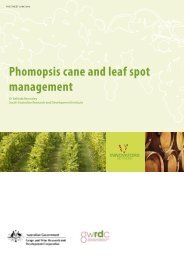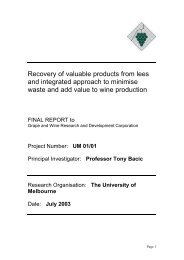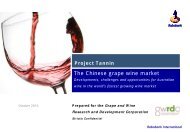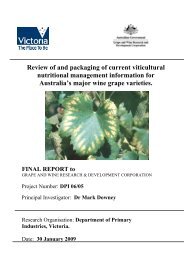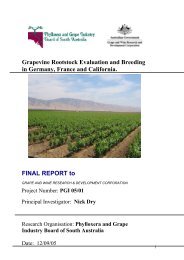Identification of the major drivers of 'phenolic' taste in ... - GWRDC
Identification of the major drivers of 'phenolic' taste in ... - GWRDC
Identification of the major drivers of 'phenolic' taste in ... - GWRDC
You also want an ePaper? Increase the reach of your titles
YUMPU automatically turns print PDFs into web optimized ePapers that Google loves.
AWRI: <strong>Identification</strong> Of The Major Drivers Of ‘Phenolic’ Taste In White W<strong>in</strong>es<br />
105<br />
Table A-1 : Resolv<strong>in</strong>g power <strong>of</strong> phenolic species <strong>in</strong> chardonnay and Riesl<strong>in</strong>g hard<br />
press<strong>in</strong>gs w<strong>in</strong>e (2009) us<strong>in</strong>g standardized <strong>in</strong>tegration parameters 1<br />
Column details Conditions used<br />
Synergi Polar RP 2<br />
(Phenomenex)<br />
4.6 x 250 mm; 4µm<br />
Synergi Hydro RP 2<br />
(Phenomenex)<br />
2.1 x 150 mm; 4µm<br />
UDC Cholesterol<br />
(Cogent)<br />
4.6 x 250 mm; 4µm<br />
Spherisorb Phenyl<br />
(Waters)<br />
4.6 x 250 mm; 5µm<br />
Ascentis Phenyl<br />
(Supelco Sigma)<br />
2.1 x 150 mm; 3µm<br />
Gem<strong>in</strong>i C6-Phenyl<br />
(Phenomenex)<br />
2.1 x 150 mm; 3µm<br />
XBridge<br />
(Waters)<br />
2.1 x 150 mm; 3.5µm<br />
K<strong>in</strong>tex PFP 3<br />
(Phenomenex)<br />
2.1 x 150 mm; 3µm<br />
Start: 1% ACN <strong>in</strong> water/1% formic acid/ 0.1%<br />
MeOH; ramp to 80% ACN /2% formic acid/10%<br />
MeOH from 5’ to 50’; hold for 5’ return over 5’; 1<br />
mL/m<strong>in</strong><br />
Start: 1% MeCN <strong>in</strong> water/1% formic acid; ramp to<br />
80% MeCN /2% formic acid from 5’ to 50’; hold for<br />
5’ return over 5’; 1 mL/m<strong>in</strong><br />
Start: 1% ACN <strong>in</strong> water/1% formic acid/ 0.1%<br />
MeOH; ramp to 80% ACN /2% formic acid/10%<br />
MeOH from 5’ to 50’; hold for 5’ return over 5’; 1<br />
mL/m<strong>in</strong><br />
Start: 1% MeOH <strong>in</strong> water/1% formic acid; ramp to<br />
80% MeOH /2% formic acid from 5’ to 50’; hold for<br />
5’ return over 5’; 0.2 mL/m<strong>in</strong>; 45°C<br />
2% formic acid constant; ramp to 40% MeOH from<br />
0’ to 50’; ramp to 100% for 5’ return over 2’; 0.3<br />
mL/m<strong>in</strong>; 45°C<br />
2% formic acid constant; ramp to 40% MeOH from<br />
0’ to 50’; ramp to 100% for 5’ return over 2’; 0.2<br />
mL/m<strong>in</strong>; 45°C<br />
2% formic acid constant; ramp to 45% MeOH from<br />
0’ to 50’; ramp to 90% for 5’ return over 2’; 0.3<br />
mL/m<strong>in</strong>; 45°C<br />
2% formic acid constant; ramp to 40% MeOH from<br />
0’ to 50’; ramp to 100% for 5’ return over 2’; 0.2<br />
mL/m<strong>in</strong>; 50°C<br />
No. peaks<br />
280 nm<br />
No. peaks<br />
A320 <br />
A280<br />
67 6<br />
No. peaks<br />
320 nm<br />
39<br />
49 7 41<br />
49 8 41<br />
41 2 12 38<br />
76 9 51<br />
108 12 86<br />
82 9 65<br />
106 13 75<br />
1 standardized <strong>in</strong>tegration parameters: slope sensitivity = 1; peak width = 0.2 m<strong>in</strong>; area reject = 50 mAublns;<br />
height reject = 5 mAu<br />
2 RP: reversed phase<br />
3 PFP: pentafluorophenyl<br />
The c<strong>in</strong>namic acids and GRP-analogues are represented where <strong>the</strong> A320 trace is <strong>the</strong> biggest and<br />
flavonols and <strong>the</strong>ir glyco-conjugates when A370 is biggest. In <strong>the</strong> example shown, <strong>the</strong> acids caftaric,<br />
coutaric, fertaric and ferulic (red A320 trace) are <strong>the</strong> most dom<strong>in</strong>ant and quercet<strong>in</strong>-3-glucuronide is <strong>the</strong><br />
<strong>major</strong> flavonol glyco-conjugate. Note all peaks elute with<strong>in</strong> 70 m<strong>in</strong>utes.<br />
Coupl<strong>in</strong>g two column toge<strong>the</strong>r <strong>in</strong> series can give an even better separation was possible if two<br />
columns were connected. It was necessary to subsequently reduce <strong>the</strong> flow rate to 0.16 mL/m<strong>in</strong> to




